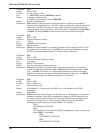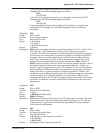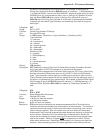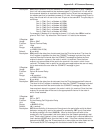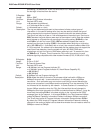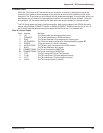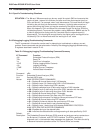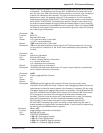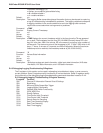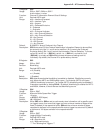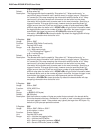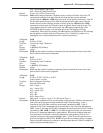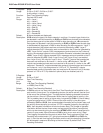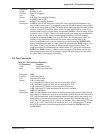
RASFinder RF300E/RF310E User Guide
RF300E/RF310E150
D.4 Troubleshooting the TA
D.4.1 Specific Troubleshooting Situations
SITUATION 1: The !Hn and *!Hn commands can be very useful for certain RAS environments that
require at least 1 second to initialize a port after a call has disconnected (such as
Citrix and Novell). For example, when a call disconnects, Citrix and Novell will begin
initializing the port that just disconnected. However, it typically takes more than 1
second and during that time a call may be received by the digital or analog port.
When this happens, Citrix and Novell do not answer the call nor do they finish the
initialization process. To prevent this problem, setting !H5 and/or *!H5 will set the TA
to hold of digital and/or analog calls for 5 seconds after the respective port(s)
disconnect(s). This should give enough time for the digital and/or analog port to be
initialized by Citrix or Novell and enter the “waiting for a call” state.
D.4.2 Debugging/Logging/Troubleshooting Commands
The AT commands in this section can be used in attempting to troubleshoot or debug a current
problem. Some commands may be enhanced or limited by the debugging/logging/troubleshooting
S-registers described in section D.4.3.
Table D-4. Debugging/Logging/Troubleshooting Command Summary
AT Command Function
>Dn Embedded Protocol Analyzer (EPA)
*FSn Reset TA
*Ln Fatal Error Information
>LOG Display Logging Buffer Contents
>Sn Logging Variables
>TIME Display Current Timestamp
*V Various State Information
Command: >Dn
Function: Embedded Protocol Analyzer (EPA)
Unit: Decimal ASCII code
Values: ANALYZER/DECODER COMMANDS
n=0—-Displays B-channel data using V.120 decoder
n=1—-Displays Layer 2 & 3 data using Q.921 & Q.931decoders
n=2—-Displays Layer 2 data using Q.921 decoder
n=3—-Displays complete Layer 3 data using long-form Q.931 decoder
n=38—Displays Layer 3 data using short-form Q.931 decoder with hex data
n=39—Displays Layer 3 data using short-form Q.931 decoder
n=4—-Displays B-channel data using X.75 decoder
n=5—-Displays Asynchronous Port data using PPP decoder
n=51—Displays Asynchronous Port data as raw asynchronous PPP data
n=6—-Displays B-channel data using PPP decoder
n=61—Displays B-channel data as raw synchronous PPP data
n=7—-Displays B-channel data in raw hexadecimal form
n=8—-Displays Layer 1 data using I.430 decoder EMBEDDED PROTOCOL
ANALYZER (EPA) INITIALIZATION COMMANDS
n=98—Disables saving to the decode buffer
n=99—Initializes the decode buffer and begins saving all data specified by S102
Default: n/a
Description: The Embedded Protocol Analyzer (EPA) records and analyzes various protocols on
the B-channel, D-channel, and DTE-DCE interface. The EPA is useful as a
diagnostic tool, in that essential data messages are displayed. This offers the ability
to observe interactive operations of the TA, Central Office, and remote



